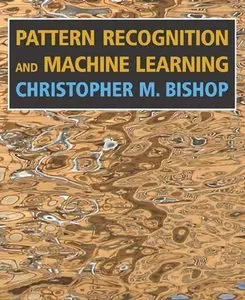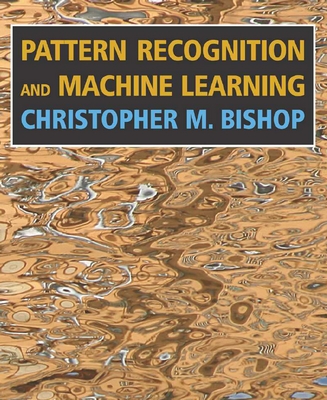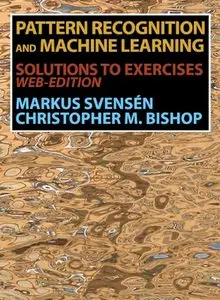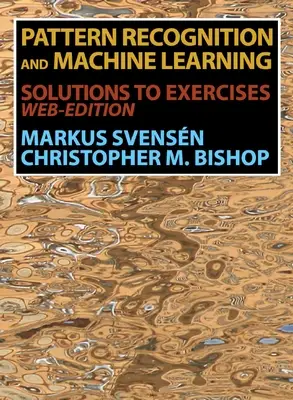"Pattern Recognition and Machine Learning" by Christopher M. Bishop
Information Science and Statistics
Sрringеr Science+Business Media | 2006 | ISBN: 0387310738 9780387310732 | 761 pages | PDF | 5 MB
Information Science and Statistics
Sрringеr Science+Business Media | 2006 | ISBN: 0387310738 9780387310732 | 761 pages | PDF | 5 MB
This textbook reflects these recent developments while providing a comprehensive introduction to the fields of pattern recognition and machine learning. No previous knowledge of pattern recognition or machine learning concepts is assumed. Familiarity with multivariate calculus and basic linear algebra is required, and some experience in the use of probabilities would be helpful though not essential as the book includes a self-contained introduction to basic probability theory.
The book is suitable for courses on machine learning, statistics, computer science, signal processing, computer vision, data mining, and bioinformatics.
Extensive support is provided for course instructors, including more than 400 exercises, graded according to difficulty. Example solutions for a subset of the exercises are available from the book web site, while solutions for the remainder can be obtained by instructors from the publisher.
Contents
Preface
Mathematical notation
Contents
1 Introduction
1.1 Example: Polynomial Curve Fitting
1.2 Probability Theory
1.2.1 Probability densities
1.2.2 Expectations and covariances
1.2.3 Bayesian probabilities
1.2.4 The Gaussian distribution
1.2.5 Curve fitting re-visited
1.2.6 Bayesian curve fitting
1.3 Model Selection
1.4 The Curse of Dimensionality
1.5 Decision Theory
1.5.1 Minimizing the misclassification rate
1.5.2 Minimizing the expected loss
1.5.3 The reject option
1.5.4 Inference and decision
1.5.5 Loss functions for regression
1.6 Information Theory
1.6.1 Relative entropy and mutual information
Exercises
2 Probability Distributions
2.1 Binary Variables
2.1.1 The beta distribution
2.2 Multinomial Variables
2.2.1 The Dirichlet distribution
2.3 The Gaussian Distribution
2.3.1 Conditional Gaussian distributions
2.3.2 Marginal Gaussian distributions
2.3.3 Bayes’ theorem for Gaussian variables
2.3.4 Maximum likelihood for the Gaussian
2.3.5 Sequential estimation
2.3.6 Bayesian inference for the Gaussian
2.3.7 Student’s t-distribution
2.3.8 Periodic variables
2.3.9 Mixtures of Gaussians
2.4 The Exponential Family
2.4.1 Maximum likelihood and sufficient statistics
2.4.2 Conjugate priors
2.4.3 Noninformative priors
2.5 Nonparametric Methods
2.5.1 Kernel density estimators
2.5.2 Nearest-neighbour methods
Exercises
3 Linear Models for Regression
3.1 Linear Basis Function Models
3.1.1 Maximum likelihood and least squares
3.1.2 Geometry of least squares
3.1.3 Sequential learning
3.1.4 Regularized least squares
3.1.5 Multiple outputs
3.2 The Bias-Variance Decomposition
3.3 Bayesian Linear Regression
3.3.1 Parameter distribution
3.3.2 Predictive distribution
3.3.3 Equivalent kernel
3.4 Bayesian Model Comparison
3.5 The Evidence Approximation
3.5.1 Evaluation of the evidence function
3.5.2 Maximizing the evidence function
3.5.3 Effective number of parameters
3.6 Limitations of Fixed Basis Functions
Exercises
4 Linear Models for Classification
4.1 Discriminant Functions
4.1.1 Two classes
4.1.2 Multiple classes
4.1.3 Least squares for classification
4.1.4 Fisher’s linear discriminant
4.1.5 Relation to least squares
4.1.6 Fisher’s discriminant for multiple classes
4.1.7 The perceptron algorithm
4.2 Probabilistic Generative Models
4.2.1 Continuous inputs
4.2.2 Maximum likelihood solution
4.2.3 Discrete features
4.2.4 Exponential family
4.3 Probabilistic Discriminative Models
4.3.1 Fixed basis functions
4.3.2 Logistic regression
4.3.3 Iterative reweighted least squares
4.3.4 Multiclass logistic regression
4.3.5 Probit regression
4.3.6 Canonical link functions
4.4 The Laplace Approximation
4.4.1 Model comparison and BIC
4.5 Bayesian Logistic Regression
4.5.1 Laplace approximation
4.5.2 Predictive distribution
Exercises
5 Neural Networks
5.1 Feed-forward Network Functions
5.1.1 Weight-space symmetries
5.2 Network Training
5.2.1 Parameter optimization
5.2.2 Local quadratic approximation
5.2.3 Use of gradient information
5.2.4 Gradient descent optimization
5.3 Error Backpropagation
5.3.1 Evaluation of error-function derivatives
5.3.2 A simple example
5.3.3 Efficiency of backpropagation
5.3.4 The Jacobian matrix
5.4 The Hessian Matrix
5.4.1 Diagonal approximation
5.4.2 Outer product approximation
5.4.3 Inverse Hessian
5.4.4 Finite differences
5.4.5 Exact evaluation of the Hessian
5.4.6 Fast multiplication by the Hessian
5.5 Regularization in Neural Networks
5.5.1 Consistent Gaussian priors
5.5.2 Early stopping
5.5.3 Invariances
5.5.4 Tangent propagation
5.5.5 Training with transformed data
5.5.6 Convolutional networks
5.5.7 Soft weight sharing
5.6 Mixture Density Networks
5.7 Bayesian Neural Networks
5.7.1 Posterior parameter distribution
5.7.2 Hyperparameter optimization
5.7.3 Bayesian neural networks for classification
Exercises
6 Kernel Methods
6.1 Dual Representations
6.2 Constructing Kernels
6.3 Radial Basis Function Networks
6.3.1 Nadaraya-Watson model
6.4 Gaussian Processes
6.4.1 Linear regression revisited
6.4.2 Gaussian processes for regression
6.4.3 Learning the hyperparameters
6.4.4 Automatic relevance determination
6.4.5 Gaussian processes for classification
6.4.6 Laplace approximation
6.4.7 Connection to neural networks
Exercises
7 Sparse Kernel Machines
7.1 Maximum Margin Classifiers
7.1.1 Overlapping class distributions
7.1.2 Relation to logistic regression
7.1.3 Multiclass SVMs
7.1.4 SVMs for regression
7.1.5 Computational learning theory
7.2 Relevance Vector Machines
7.2.1 RVM for regression
7.2.2 Analysis of sparsity
7.2.3 RVM for classification
Exercises
8 Graphical Models
8.1 Bayesian Networks
8.1.1 Example: Polynomial regression
8.1.2 Generative models
8.1.3 Discrete variables
8.1.4 Linear-Gaussian models
8.2 Conditional Independence
8.2.1 Three example graphs
8.2.2 D-separation
8.3 Markov Random Fields
8.3.1 Conditional independence properties
8.3.2 Factorization properties
8.3.3 Illustration: Image de-noising
8.3.4 Relation to directed graphs
8.4 Inference in Graphical Models
8.4.1 Inference on a chain
8.4.2 Trees
8.4.3 Factor graphs
8.4.4 The sum-product algorithm
8.4.5 The max-sum algorithm
8.4.6 Exact inference in general graphs
8.4.7 Loopy belief propagation
8.4.8 Learning the graph structure
Exercises
9 Mixture Models and EM
9.1 K-means Clustering
9.1.1 Image segmentation and compression
9.2 Mixtures of Gaussians
9.2.1 Maximum likelihood
9.2.2 EM for Gaussian mixtures
9.3 An Alternative View of EM
9.3.1 Gaussian mixtures revisited
9.3.2 Relation to K-means
9.3.3 Mixtures of Bernoulli distributions
9.3.4 EM for Bayesian linear regression
9.4 The EM Algorithm in General
Exercises
10 Approximate Inference
10.1 Variational Inference
10.1.1 Factorized distributions
10.1.2 Properties of factorized approximations
10.1.3 Example: The univariate Gaussian
10.1.4 Model comparison
10.2 Illustration: Variational Mixture of Gaussians
10.2.1 Variational distribution
10.2.2 Variational lower bound
10.2.3 Predictive density
10.2.4 Determining the number of components
10.2.5 Induced factorizations
10.3 Variational Linear Regression
10.3.1 Variational distribution
10.3.2 Predictive distribution
10.3.3 Lower bound
10.4 Exponential Family Distributions
10.4.1 Variational message passing
10.5 Local Variational Methods
10.6 Variational Logistic Regression
10.6.1 Variational posterior distribution
10.6.2 Optimizing the variational parameters
10.6.3 Inference of hyperparameters
10.7 Expectation Propagation
10.7.1 Example: The clutter problem
10.7.2 Expectation propagation on graphs
Exercises
11 Sampling Methods
11.1 Basic Sampling Algorithms
11.1.1 Standard distributions
11.1.2 Rejection sampling
11.1.3 Adaptive rejection sampling
11.1.4 Importance sampling
11.1.5 Sampling-importance-resampling
11.1.6 Sampling and the EM algorithm
11.2 Markov Chain Monte Carlo
11.2.1 Markov chains
11.2.2 The Metropolis-Hastings algorithm
11.3 Gibbs Sampling
11.4 Slice Sampling
11.5 The Hybrid Monte Carlo Algorithm
11.5.1 Dynamical systems
11.5.2 Hybrid Monte Carlo
11.6 Estimating the Partition Function
Exercises
12 Continuous Latent Variables
12.1 Principal Component Analysis
12.1.1 Maximum variance formulation
12.1.2 Minimum-error formulation
12.1.3 Applications of PCA
12.1.4 PCA for high-dimensional data
12.2 Probabilistic PCA
12.2.1 Maximum likelihood PCA
12.2.2 EM algorithm for PCA
12.2.3 Bayesian PCA
12.2.4 Factor analysis
12.3 Kernel PCA
12.4 Nonlinear Latent Variable Models
12.4.1 Independent component analysis
12.4.2 Autoassociative neural networks
12.4.3 Modelling nonlinear manifolds
Exercises
13 Sequential Data
13.1 Markov Models
13.2 Hidden Markov Models
13.2.1 Maximum likelihood for the HMM
13.2.2 The forward-backward algorithm
13.2.3 The sum-product algorithm for the HMM
13.2.4 Scaling factors
13.2.5 The Viterbi algorithm
13.2.6 Extensions of the hidden Markov model
13.3 Linear Dynamical Systems
13.3.1 Inference in LDS
13.3.2 Learning in LDS
13.3.3 Extensions of LDS
13.3.4 Particle filters
Exercises
14 Combining Models
14.1 Bayesian Model Averaging
14.2 Committees
14.3 Boosting
14.3.1 Minimizing exponential error
14.3.2 Error functions for boosting
14.4 Tree-based Models
14.5 Conditional Mixture Models
14.5.1 Mixtures of linear regression models
14.5.2 Mixtures of logistic models
14.5.3 Mixtures of experts
Exercises
Appendix A Data Sets
Appendix B Probability Distributions
Appendix C Properties of Matrices
Appendix D Calculus of Variations
Appendix E Lagrange Multipliers
References
Index
with TOC BookMarkLinks
About:
Christopher Bishop is Assistant Director at Microsoft Research Cambridge, and also holds a Chair in Computer Science at the University of Edinburgh. He is a Fellow of Darwin College Cambridge, and was recently elected Fellow of the Royal Academy of Engineering.





